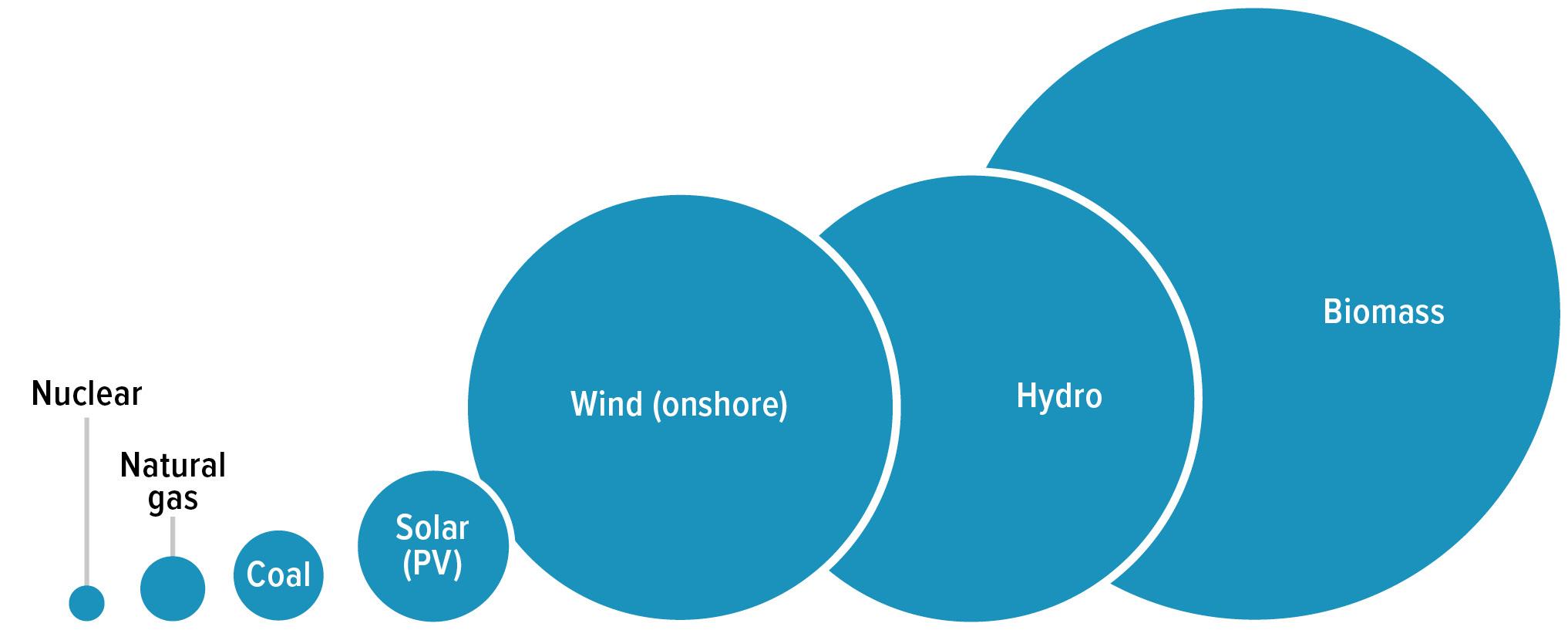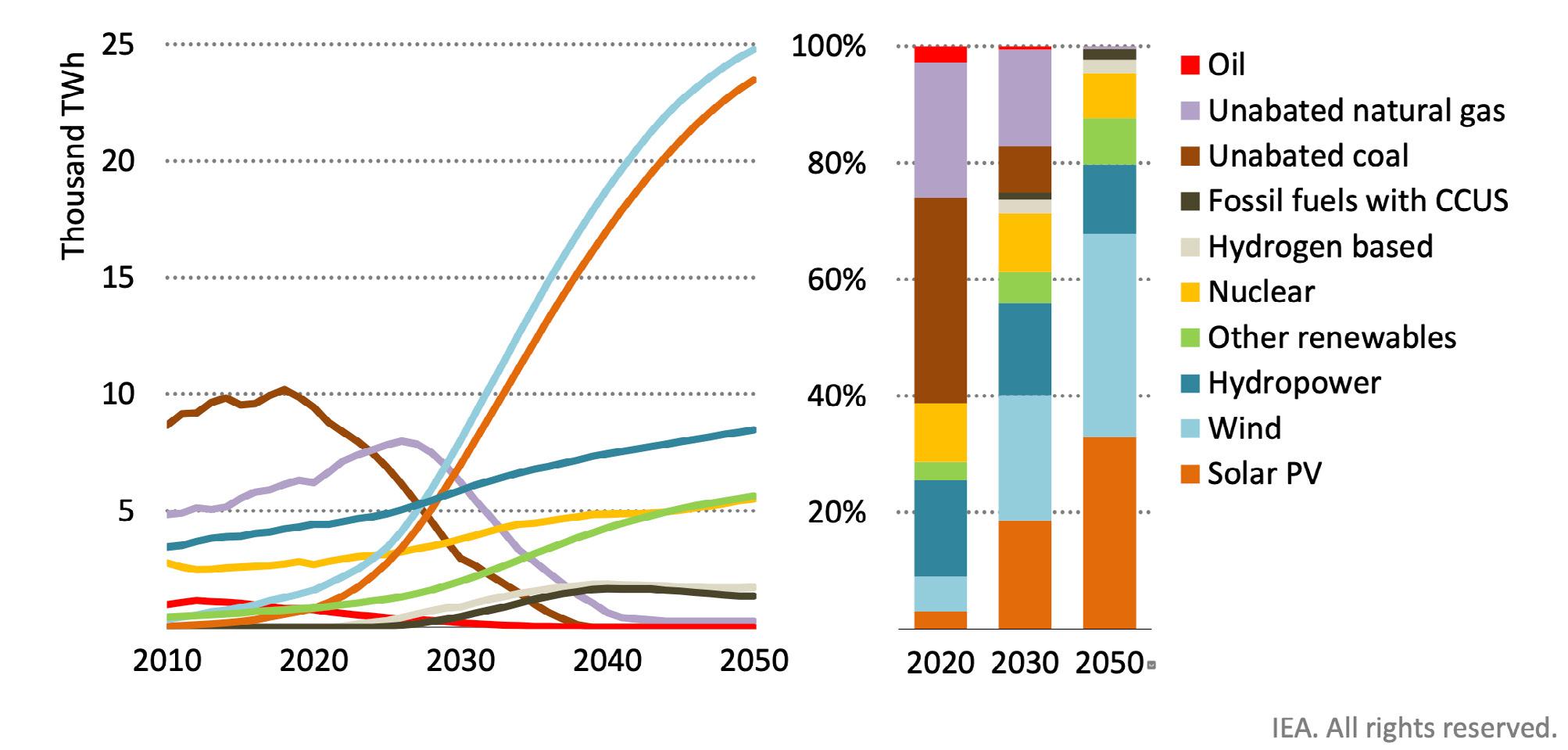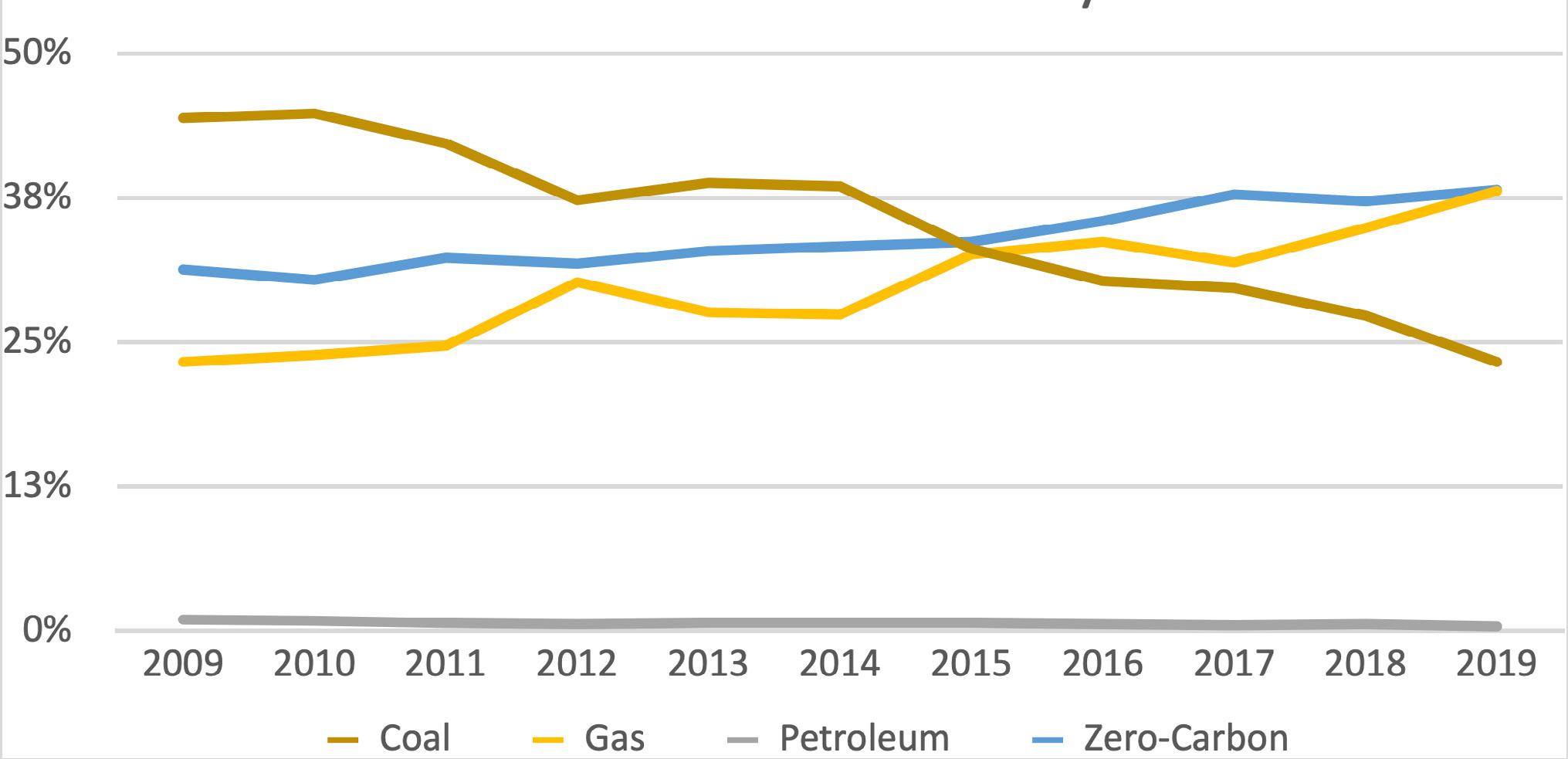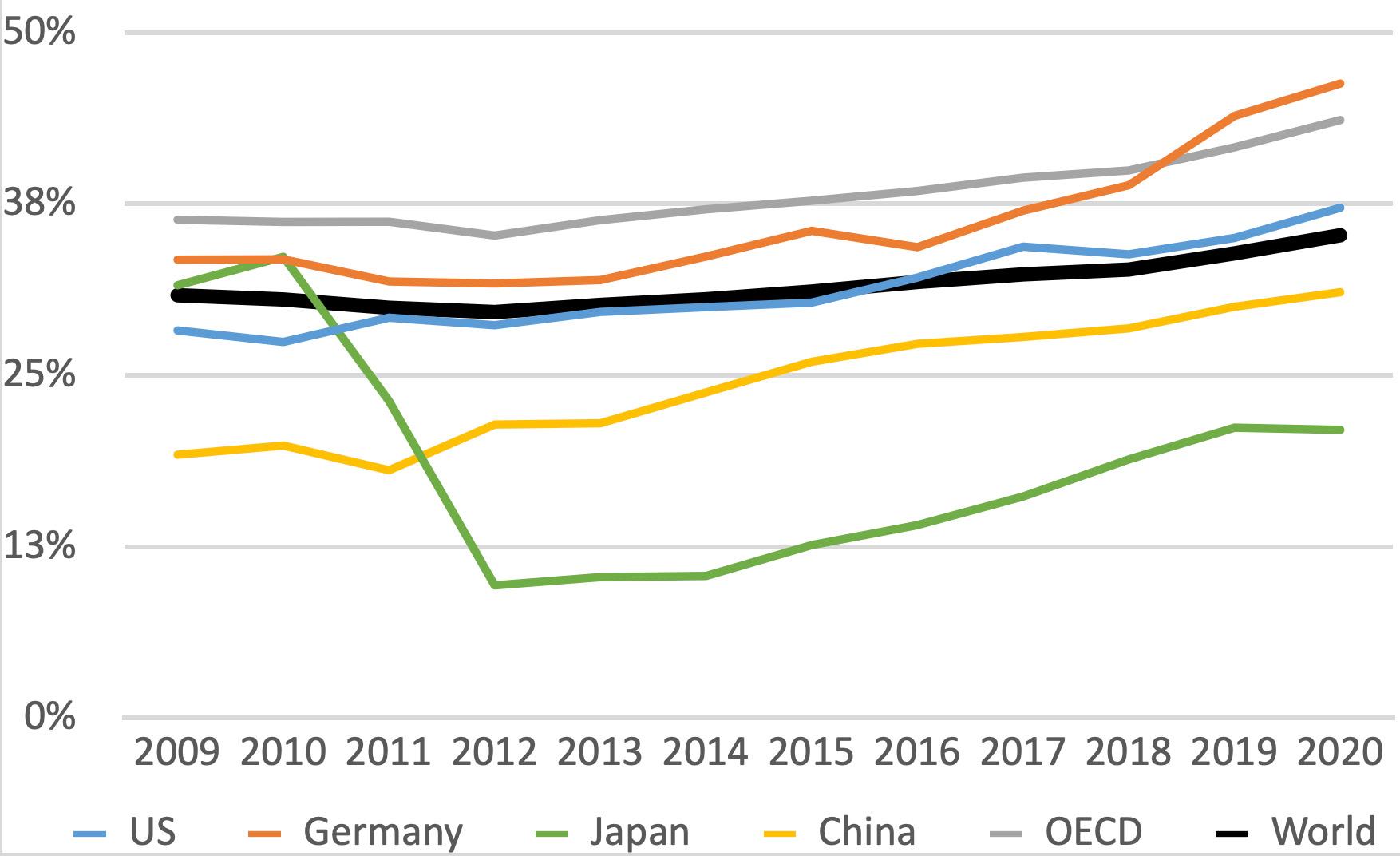
16 minute read
I. Nuclear Energy and Decarbonization
Nuclear energy has among the lowest levels of lifecycle carbon-dioxide (CO2) emissions of all power-generation options, according to some studies, lower than wind or solar energy.8 Nuclear energy is both time independent (it is dispatchable, and its availability does not vary with weather conditions) and location independent (it does not depend on natural availability of renewable resources like hydropower, wind, solar, or geothermal energy).9 It, therefore, provides a route to zero-carbon energy for regions where renewable resources are less available, and provides power that is not subject to weather variability, reducing the need for energy storage and its associated costs. It provides another option for zero-carbon energy that is less land intensive than renewables, and that imposes less of an impact on the physical space (e.g., less of a visibility impact), representing an alternative approach that may be more attractive to some communities.
Today, nuclear power is a major source of zero-carbon energy. It is the largest source of zero-carbon electricity in “advanced economies,” as defined by the International Energy Agency (IEA), representing 40 percent of zero-carbon power and exceeding the output of renewable generation, despite recent efforts to accelerate deployment of wind and solar power.10 Nuclear energy is also a cornerstone of the US power sector, representing 20 percent of electric generation (including about half of zero-carbon electricity) and 25 percent in the European Union (about 40 percent of zero-carbon electricity).
There is now extensive development of advanced nuclear designs that take new approaches to nuclear energy. These advanced designs make construction more efficient, integrate more readily into power systems that include variable renewable generation, make safety and security part of the inherent design (which also decreases costs and increases siting options), and, in many cases, can support industrial power needs and efficient hydrogen production, in addition to electric generation.11 The attributes of advanced nuclear reactors include the following.
•Efficient construction: advanced designs can be modular, with an emphasis on components that can be manufactured in a factory, and which, therefore, require less onsite construction and result in shorter construction times. Long construction times are a key contributor to high costs, with the cost of construction financing representing a significant portion of traditional nuclear power costs. Modular design also allows more rapid iteration, resulting in improved cost and efficiency through technological learning.
•Better integration: modular designs allow generation capacity to be added in smaller increments, better matching growth needs and imposing less financial stress on project sponsors. Advanced designs also incorporate greater ability to change power output levels than traditional designs (especially those historically used in the
United States); some emphasize fast ramping speeds to rapidly respond to changing levels of renewable power, and some incorporate thermal energy storage, which may be more cost effective than battery storage.
•Inherent safety and security: advanced approaches incorporate safety features as an inherent element of the designs, typically relying on “passive” features, such as gravity or natural heat convection, to cool reactors without requiring mechanical intervention. In addition to making safety systems even more reliable, this approach reduces the amount of equipment required to ensure safety, which decreases overall costs.
8 Hannah Ritchie, “What Are the Safest and Cleanest Sources of Energy?” Our World in Data, February 10, 2020, https://ourworldindata.org/safest-sources-of-energy. 9 Conventional nuclear power plants require water for cooling, though there are options to reduce the impact on water resources, and many advanced nuclear technologies use alternative approaches that avoid significant water use. 10 “Nuclear Power in a Clean Energy System,” International Energy Agency, May 2019, https://www.iea.org/reports/nuclear-power-in-a-clean-energy-system. 11 There are several references for more complete technical discussions of advanced nuclear technology, such as International Atomic Energy Agency, Division of Nuclear Power, Nuclear Power Technology Development Section, Vienna (Austria) (2020); “Advances in Small Modular Reactor Technology Developments A Supplement to: IAEA Advanced Reactors Information System (ARIS) 2020 Edition,” International Atomic Energy Agency, September 2020, https://inis.iaea.org/search/ search.aspx?orig_q=RN:51111609; “Advanced Nuclear Reactor Technology: A Primer,” Nuclear Innovation Alliance, 2021, https://www.nuclearinnovationalliance.org/ advanced-nuclear-reactor-technology-primer.
SOURCE: “NUCLEAR ENERGY AND SUSTAINABLE DEVELOPMENT,” WORLD NUCLEAR ASSOCIATION, UPDATED APRIL 2020, HTTPS://WORLD-NUCLEAR.ORG/INFORMATION-LIBRARY/ENERGY-AND-THE-ENVIRONMENT/NUCLEAR-ENERGY-AND-SUSTAINABLE-DEVELOPMENT.ASPX.
•Industrial integration: many designs incorporate high-temperature output compatible with many industrial requirements (discussed further below), which also improve the ability of the reactor to produce hydrogen.
The two demonstrations funded under the US Advanced Reactor Demonstration Program (ARDP) involve designs incorporating many of these features. The Natrium design to be constructed in Wyoming allows the reactor to operate at a steady output equivalent to three hundred and forty-five megawatts (MW), but incorporates a thermal storage system so that it can deliver as little as one hundred megawatts while renewable energy is available, but up to five hundred megawatts for 5.5 hours when renewable energy production decreases, such as in the evening in a system with substantial solar power.12 The X-energy Xe-100 reactor to be constructed in the state of Washington is built in 80-MW modules, operates at high temperatures with a helium coolant, and incorporates continuous refueling with tri-structural isotropic (TRISO) particle fuel that can withstand high temperatures and does not melt.13
Deployment Flexibility
Nuclear energy, by its nature, produces a substantial amount of energy in a small land area, especially compared to renewable power. A two-unit nuclear power plant able to provide electricity for four to five million people covers a footprint of just two square kilometers.14 For an equal amount of lifetime energy, solar photovoltaic generation may require about sixty times as much land as nuclear generation, and wind generation may cover almost five hundred times as much land, though the space between the turbines can be put to other uses (See Figure 1).15
12 “Advanced Nuclear Reactor Technology.” 13 Ibid.; “X-Energy,” X-Energy, last visited May 6, 2022, https://x-energy.com/. 14 “Nuclear Energy and Sustainable Development,” World Nuclear Association, last updated April 2020, https://world-nuclear.org/information-library/energy-and-theenvironment/nuclear-energy-and-sustainable-development.aspx. 15 Estimates of land use for power generation vary widely. These estimates are from Barry W. Brook and Corey J. A. Bradshaw, “Key Role for Nuclear Energy in Global Biodiversity Conservation,” Conservation Biology (2015): 702–712, https://conbio.onlinelibrary.wiley.com/doi/epdf/10.1111/cobi.12433.
The modular design, moderate size, and inherent safety features of advanced nuclear approaches enable flexibility in deploying new generation. The Natrium demonstration project, for example, will demonstrate the feasibility of siting new nuclear generation at the site of a retired coal plant. Doing so will enable using a brownfield site rather than developing new land for power generation, will take advantage of existing electrical infrastructure, such as the substation and transmission, and will benefit the community through providing jobs to replace those lost to the coal plant retirement and through adding to the tax base. Four communities sought to be considered for the demonstration and the project ultimately selected a site in Kemmerer, Wyoming.16
Resilience
Nuclear power plants are capable of dispatchable operation to operate in systems alongside renewable generation. As noted earlier, advanced nuclear designs are capable of extended power flexibility (ramping), and some incorporate efficient thermal storage. They are also capable of continued, reliable generation that is not subject to weather conditions, such as those that can threaten systems that rely on high concentrations of renewable power.
Furthermore, nuclear generation is highly resilient under extreme weather conditions. Nuclear refueling cycles are more than a year long, so they are relatively insulated against fuel supply challenges such as those faced by natural-gas dependent regions today, or those that affected Asian liquefied natural gas (LNG) users and US natural gas generation during extended winter conditions in early 2021, and even against extended supply shortages. If properly weatherized, nuclear generators can operate reliably in the harshest conditions. For example, although one nuclear unit incurred an outage due to cold weather impacts on its feedwater system (which were avoidable with proper winterization) during the Texas winter storm in early 2021, it was restored to full power within three days.17 Nuclear plants had the best performance of any generation technology during that event, delivering 79 percent of their expected performance, compared to natural gas generators at 55 percent and wind at 57 percent.18
Industrial Energy
One of the more challenging areas of energy use to decarbonize is industrial process heat. Worldwide, about 75 percent of industrial heat is generated with fossil fuels.19 Many advanced nuclear technologies, including those in the ARDP, are able to generate temperatures higher than conventional reactors because of their innovative fuels and coolants. These reactors can produce heat in the range of 600–800 degrees Celsius, which is suitable for many industrial requirements, such as pulp and paper manufacturing, methanol production, and ammonia synthesis.20 Japan’s High Temperature Engineering Test Reactor (HTTR) can produce heat at nine hundred and fifty degrees Celsius, potentially opening the door to further industrial applications.21
Hydrogen
Obtaining even higher temperatures, such as those required for steel production with blast furnaces, cement, and glass production, may require the use of alternative fuels that can be combusted without producing CO2. Hydrogen has attracted great interest as a potential fuel, or as a key precursor to alternative fuels, such as ammonia. Hydrogen or alternative fuels made with hydrogen may also be critical to support carbon-free freight transport, such as heavy trucking and marine transport, for which battery power may be inadequate or impractical.
Much of the discussion about producing hydrogen has focused on production through electrolysis using renewable electricity (so-called “green” hydrogen) or adding carbon capture to the current carbon-intensive production through methane (natural gas) reforming (with carbon capture, this is so-called “blue” hydrogen). Hydrogen can also be produced through electrolysis using nuclear electricity, and doing so could have some advantages (some discussions characterize nuclear-produced hydrogen as “pink,” but the color scheme is faulty; because nuclear electricity is carbon free, there is no reason to designate it differently than hydrogen produced by renewables).
16 Dan Yurman, “TerraPower Selects Kemmerer WY for Natrium Reactor,” Neutron Bytes, November 18, 2021, https://neutronbytes.com/2021/11/18/terrapower-selectskemmerer-wy-for-natrium-reactor. 17 Michael McAuliffe, “Texas Nuclear Unit Returns to Service after Outage Related to Cold Weather,” S&P Global, February 18, 2021, https://www.spglobal.com/platts/en/ market-insights/latest-news/electric-power/021821-texas-nuclear-unit-returns-to-service-after-outage-related-to-cold-weather. 18 Derek Stenclik, et al., “Redefining Resource Adequacy for Modern Power Systems,” Energy Systems Integration Group, 2021, https://www.esig.energy/resourceadequacy-for-modern-power-systems/. 19 Nathaniel Bullard, “Taking the Gas (and Coal) Out of Heat,” Bloomberg, September 16, 2021, https://www.bloomberg.com/news/articles/2021-09-16/making-things-hottranslates-to-substantial-greenhouse-gas-emissions. 20 Julio Friedmann, Zhiyuan Fan, and Ke Tang, “Low-Carbon Heat Solutions for Heavy Industry: Sources, Options, and Costs Today,” Columbia University School of International and Public Affairs, Center on Global Energy Policy, October 7, 2019, https://www.energypolicy.columbia.edu/research/report/low-carbon-heat-solutionsheavy-industry-sources-options-and-costs-today. 21 https://www.nice-future.org/assets/pdfs/japan.pdf.
The key factors in hydrogen production through electrolysis are the cost of the electricity, the capacity factor (percent of output) of the available power, and the capital cost and efficiency of the electrolyzer. The standalone cost of power from a new solar or wind project (without considering system costs that may be necessary to integrate these projects) is less than that from a new nuclear power plant, though advanced nuclear plants may be able to decrease their costs when they have had more time to mature, as renewable technologies have.22 However, the capacity factor for nuclear power plants is much greater than that for renewable power; in the United States in 2019, the average capacity factor for nuclear power was 94 percent vs. 35 percent for wind and 25 percent for solar.23 The higher capacity of nuclear power results in better utilization of the electrolyzer, and so can partially offset a higher average per unit cost of power. Furthermore, nuclear power, which produces heat, can be used to support high-temperature electrolysis that uses 24 percent less energy than the approach that can be used with renewables.24 Using its HTTR, the Japan Atomic Energy Agency (JAEA) is testing a thermochemical method of hydrogen production that could result in even greater efficiency.25
Considering these factors could make hydrogen production with nuclear energy attractive compared with production using renewables. The US Department of Energy, through the Idaho National Laboratory, has conducted several assessments of hydrogen production with nuclear energy. Some conclude that such approaches could deliver hydrogen for $1–2 per kilogram of hydrogen, in the target range for the hydrogen “Earthshot” program.”26 The Department of Energy is currently sponsoring several demonstrations of hydrogen production at existing nuclear plants.27 Most of these demonstrations will incorporate low-temperature electrolysis, due to the technical constraints of demonstrations at existing facilities; however, one demonstration in Minnesota will test high-temperature electrolysis.28 In addition to better capacity factors and better efficiency, production of hydrogen with nuclear energy could be located closer to demand centers, thereby mitigating the complications of storing and transporting hydrogen, especially in the early stages of a developing hydrogen infrastructure.29 Nuclear power plants in industrial hubs could supply both process heat and hydrogen. Hydrogen could be produced with nuclear power at shipping hubs to support marine transport.30 Hydrogen produced with nuclear power would be particularly suitable for Japan, because renewable generation options are limited, natural gas is not readily available in Japan for hydrogen production using methane reforming, and seaborne hydrogen transport is difficult and inefficient.
Worldwide Interest in Nuclear Power
In the context of climate change and a desire to achieve independence from reliance on fossil fuels, interest in nuclear energy has grown worldwide, beyond the efforts in the United States. Ontario, Canada, already relies on nuclear power for 60 percent of its electric generation.31 In December 2019, it signed a memorandum of understanding (MOU) with the provinces of New Brunswick and Saskatchewan to collaborate on advancing development and deployment of a small modular reactor (SMR). The MOU contemplates three streams of deployment: initial deployment of a three-hundred-megawatt reactor in Ontario (Darlington site) by 2028, with subsequent deployments in Saskatchewan; deployment of advanced reactors in New Brunswick (Point Lepreau); and demonstration of a microreactor in Ontario.32 Engineering and design work for the Darlington SMR was pursued with three developers, and, in December 2021, Ontario Power chose to proceed with GE-Hitachi’s BWRX300 reactor.33 The Ontario microreactor, Global First Power’s fifteen-megawatt thermal demonstration of the Ultra Safe
22 “Levelized Cost Of Energy, Levelized Cost Of Storage, and Levelized Cost Of Hydrogen 2020,” Lazard, October 19, 2020, https://www.lazard.com/perspective/lcoe2020. 23 “Infographic—Capacity Factor by Energy Source—2019,” US Department of Energy, Office of Nuclear Energy, May 19, 2020, https://www.energy.gov/ne/downloads/infographic-capacity-factor-energy-source-2019. 24 Mark F. Ruth, et al., “The Technical and Economic Potential of the H2@Scale Concept within the United States,” National Renewable Energy Laboratory, October 2020, https://www.nrel.gov/docs/fy21osti/77610.pdf. 25 Matt Fisher, “Nuclear Energy for Non-Electric Applications Key for Climate Change Mitigation,” International Atomic Energy Agency, Department of Nuclear Energy, August 7, 2020, https://www.iaea.org/newscenter/news/nuclear-energy-for-non-electric-applications-key-for-climate-change-mitigation. 26 See, e.g., Richard D. Boardman, “Evaluation of Non-electric Market Options for a Light-water Reactor in the Midwest. Light Water Reactor Sustainability Program,” US Department of Energy, Office of Scientific and Technical Information, August 1, 2019, https://www.osti.gov/biblio/1559965-evaluation-non-electric-market-options-lightwater-reactor-midwest; “Secretary Granholm Launches Hydrogen Energy Earthshot to Accelerate Breakthroughs Toward a Net-Zero Economy,” US Department of Energy, press release, June 7, 2021, https://www.energy.gov/articles/secretary-granholm-launches-hydrogen-energy-earthshot-accelerate-breakthroughs-toward-net. 27 David Kramer, “Could Hydrogen Bail out Nuclear Power?” Physics Today (2020): 20–21, https://physicstoday.scitation.org/doi/10.1063/PT.3.4543. 28 “Xcel Energy’s Prairie Island Likely Hydrogen Demo Site,” Nuclear News, November 11, 2020, https://www.ans.org/news/article-2366/xcel-energys-prairie-island-likely-hydrogen-demo-site/. 29 See, e.g., Cynthia Quarterman, Brief 3: Hydrogen Transportation and Storage, Atlantic Council, July 21, 2019, https://www.atlanticcouncil.org/content-series/hydrogen-policy-sprint/hydrogen-policy-sprint-brief-3/. 30 Mike Fowler, et al., “Bridging the Gap: How Nuclear-Derived Zero-Carbon Fuels Can Help Decarbonize Marine Shipping,” Clean Air Task Force, August 4, 2021, https://www.catf.us/resource/nuclear-zero-carbon-fuels-shipping/. 31 “2021 Year in Review,” Independent Electricity System Operator, 2021, https://www.ieso.ca/corporate-ieso/media/year-end-data. 32 “Ontario,” Canada’s SMR Action Plan, December 18, 2020, https://smractionplan.ca/content/ontario. 33 Matthew McClearn and Laura Stone, “Ontario Power Generation Announces Who Will Design New Modular Reactor,” Globe and Mail, December 1, 2021, https://www.theglobeandmail.com/canada/article-ontario-power-generation-announces-who-will-design-new-modular-reactor.
Nuclear Corporation’s high-temperature gas microreactor, is expected to be deployed in 2025.34
Parts of Europe already rely on nuclear power for a substantial part of their electric generation. Fourteen of the twenty-eight EU member states generate electricity with nuclear power, which provides 27 percent of European electric generation and 50 percent of its low-carbon electricity.35 The UK has committed to nuclear power as part of its net-zero strategy. As noted earlier, France has committed to relaunch construction of nuclear reactors.36 In the Netherlands, the government commissioned an assessment of nuclear power as part of its review of options for the energy transition. This assessment found that the system costs for nuclear power are lower than those for variable renewables, and, after adjusting for those system costs, the effective levelized cost for nuclear could be lower than that for wind or solar.37 The Netherlands could consider additional nuclear power after 2030, particularly small modular reactors.38 In Central and Eastern Europe, the government of Poland has strong interest in nuclear power as a means of transitioning out of the country’s heavy reliance on coal, and signed an agreement with the US government to collaborate on a civil nuclear program, which led to a letter of intent from the US Export-Import Bank to support the project.39 Romania, Bulgaria, and Ukraine have also expressed interest in working with the United States on nuclear power.40 And, in November 2021 (during COP26), Romanian nuclear energy producer Nuclearelectrica agreed to deploy a NuScale SMR.41 In July, 2021, nearly one hundred Members of the European Parliament signed a letter calling on the European Commission to include nuclear power in the EU’s Sustainable Finance Taxonomy as an essential step in recognizing and supporting nuclear power’s role as a tool to address the climate crisis.42 In July 2022, the European Parliament voted to include nuclear power in the Taxonomy as a sustainable transition resource, albeit with limitations.43
Nuclear power can serve as an element of sustainable development, not only in decarbonizing the energy sector, but also supporting the attainment of other sustainable-development goals.44 The World Nuclear Association identifies about thirty countries that are considering, planning, or starting nuclear-power programs.45 The US think tank Third Way has characterized global markets for advanced nuclear technology, and identified significant opportunities for new nuclear development in new-to-nuclear countries, as well as countries currently operating nuclear power plants with growing energy demand and/or the need to replace coal-fired generation.46 However, the World Bank continues to reject funding for nuclear power.47
Advanced nuclear technologies may be of particular interest in many new-to-nuclear countries, as those technologies are designed to add generation in smaller increments that may be more easily integrated into smaller or developing power systems. For that interest to materialize, it is essential that these technologies be initially deployed in countries where nuclear generation is already established, to provide the assurance of review by established regulatory processes, and some clarity on cost and construction feasibility.
34 Alan Ahn, et al., “Advanced Reactors: Turning the Corner,” Advanced Nuclear Energy, June 16, 2021, https://www.advancednuclearenergy.org/product/advanced-reactors-turning-the-corner. 35 “Nuclear Generates Almost Half of Europe’s Low-Carbon Electricity,” FORATOM, last visited May 6, 2022, https://www.foratom.org/facts-figures/. 36 Ingrid Melander, “Macron Says France Will Build New Nuclear Energy Reactors,” Reuters, November 9, 2021, https://www.reuters.com/business/energy/macron-says-france-will-build-more-nuclear-energy-reactors-2021-11-09. 37 “Possible Role of Nuclear in the Dutch Energy Mix in the Future,” Ministry of Economic Affairs and Climate Policy of the Netherlands, September 1, 2020, https://www.rijksoverheid.nl/ministeries/ministerie-van-economische-zaken-en-klimaat/documenten/rapporten/2020/09/22/possible-role-of-nuclear-in-the-dutchenergy-mix-in-the-future. This condition may also be the case in Japan. See: “Outline of Strategic Energy Plan,” Ministry of Economy, Trade, and Industry (Japan), October 2021, https://www.enecho.meti.go.jp/en/category/others/basic_plan/pdf/6th_outline.pdf. 38 “Netherlands Considers More Nuclear Power,” Nuclear Energy International, September 28, 2020, https://www.neimagazine.com/news/newsnetherlands-pushes-for-more-nuclear-8153490. 39 Cole Simons, “America: The Trusted Partner for Nuclear Exports,” ClearPath, November 19, 2020, https://clearpath.org/our-take/america-the-trusted-partner-for-nuclear-energy-exports. 40 Ibid. 41 “Romania’s Nuclearelectrica and the US NuScale Power Team Up to Bring First SMRs to Europe,” CEENERGYNEWS, November 15, 2021, https://ceenergynews.com/nuclear/romanias-nuclearelectrica-and-the-us-nuscale-power-team-up-to-bring-first-smrs-to-europe. 42 “MEPs Call on EC to Recognize Nuclear as Sustainable,” World Nuclear News, July 9, 2021, https://www.world-nuclear-news.org/Articles/MEPs-call-on-EC-to-recognise-nuclear-as-sustainabl. 43 https://www.reuters.com/business/sustainable-business/eu-parliament-vote-green-gas-nuclear-rules-2022-07-06/. 44 “The Role of Nuclear Energy in Sustainable Development,” United Nations Economic Commission for Europe, 2020, https://unece.org/fileadmin/DAM/energy/se/pdfs/egrm/egrm11_apr2020/EGRM-11_The_Role_of_Nuclear_Energy_in_Sustainable_Development__v11.pdf. 45 “Emerging Nuclear Energy Countries,” World Nuclear Association, January 2020, https://world-nuclear.org/information-library/country-profiles/others/emerging-nuclear-energy-countries.aspx. 46 Alan Ahn, et al., “2021 Update: Map of the Global Market for Advanced Nuclear,” Third Way, November 9, 2021, https://www.thirdway.org/memo/2021-update-map-of-the-global-market-for-advanced-nuclear. 47 Jonathan Tirone, “Nuclear Watchdog’s Pitch for World Bank Financing Makes Headway,” Bloomberg, October 25, 2021, https://www.bloomberg.com/news/articles/2021-10-25/nuclear-watchdog-s-pitch-for-world-bank-financing-makes-headway.





